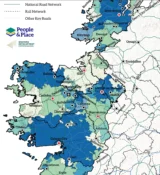- More people living in the Western Region and at work – up by over 13% since last Census
- Nearly 30% (29.9%) of all workers in the Western Region live in Galway city catchment, up 3% since last Census
- Rurally based employment is still important, often the 2nd most important destination outside of the key centre
- Increased education levels across all seven labour catchments
A new report carried out by the Western Development Commission (WDC) examining travel to work patterns and labour catchments in the Western Region finds the number of people living and working in the Western Region has increased by 13.3% between 2016 and 2022.
This is based on a subset of Census 2022 data examining where people live and work and forms the basis of the labour catchments.
The town labour catchment is that area from which a town draws most of its’ workforce. Therefore it is a very useful measure of labour supply.
All the labour catchments reviewed in this report have significantly more people at work than the census population at work within the town. This shows that all of these towns have access to a much greater labour supply than the town population.
As noted by Deirdre Frost, Policy Analyst,
This information, along with the labour market profiles of those described throughout this report, will help inform the development agencies, employers and local authorities on employment and enterprise across the Western Region.
Download Carrick-on-Shannon Catchment Area Report
Download Castlebar Catchment Area Report
Download Ennis Catchment Area Report
Download Galway City Catchment Area Report
Download Letterkenny Catchment Area Report
Download Roscommon Town Catchment Area Report
Download Sligo Town Catchment Area Report

Key Findings
All of the larger catchments recorded increases in the number of workers there in the intercensal period 2016-2022, with the Galway city and Roscommon town labour catchments having the greatest increases; 25.8% and 26.7% respectively.
Unsurprisingly, the Galway city labour catchment is by far the largest. Between 2016 and 2022 it grew by over a quarter (25.8%), over 18,000 workers to 88,253. This accounted for 52% of the overall growth in the number of resident workers across all labour catchments in the Western Region.
The Sligo town labour catchment is the 2nd largest in 2022, with over 24,300 resident workers an increase of 11.7% since 2016.
The Letterkenny town labour catchment was the 3rd largest in 2022 with 23,500 resident workers. It grew by 19% since 2016 and moved from 4th largest in 2016 to 3rd in 2022.
Growth (or decline) in labour catchments may sometimes reflect what is happening in centres nearby. This is true for example in the case of the Ennis labour catchment which recorded a lower rate of growth + 4.4%. This is as much about the importance of adjacent centres such as Shannon and Limerick and their relative importance as employment destinations. CSO boundary changes sometimes can be a factor too.
The report also highlights the importance of rural areas as employment locations.
A large proportion of the labour catchment residents are in fact employed in rural areas – centres with less than 1,000 people, destinations outside any defined CSO settlement. These rural locations are the second most popular workplace destination for even the larger, more urban labour catchments.
Castlebar is the fifth largest labour catchment in the Western Region with nearly 17,000 resident workers in 2022. It retained this 5th position throughout the period 2006-2022. It recorded one of the largest growth rates of all catchments, growing by 22% since 2016.
Roscommon town labour catchment is the 8th largest catchment in the Western Region, up from its ranking of 9th place in 2016. It had the highest growth rate of the principal catchments, it grew by 1,933 resident workers or 26.7% between 2016 and 2022.
The largest catchment in Co. Leitrim, the Carrick-on-Shannon labour catchment was the 10th largest across the Western Region.
The report illustrates the socio-economic profile of workers across the catchments.
- There is a continued increase in third level attainment levels with rates nationally increasing from 56.1% in 2016 to 63.1% in 2022. In 2022, the Galway City labour catchment has a higher rate of third level education attainment (67.6%) than the State. Sligo town, Ennis and Carrick-on-Shannon had similar levels to the State.
- In each of the seven labour catchments, the most significant employment sector is the ‘Education, Human Health and Social Work Activities’, ranging from 23.9% of all employment in the Carrick-on-Shannon labour catchment to 29.9% in Letterkenny labour catchment. This is the most significant employment sector in all seven labour catchments and is also the largest sector nationally (23.8%).
- Along with industry, other characteristics such as socio-economic group, gender, means of travel to work and travel departure times are also discussed.
- The impact of the widespread adoption of working from home is clearly evident. The number of people who recorded that they worked mainly from home in Ireland increased by +133%, from 111,744 workers in 2016 (5.7%) to 260,821 in 2022 (11.4%). Within the Western Region, the number who worked mainly from home increased by +75.6% (+17,420) since Census 2016.
- Since 2016, across many of the catchments there is an increase in the numbers citing longer distance locations such as Dublin as their place of work. This may be facilitated by the higher incidence of working from home. The detail on each labour catchment is outlined in the report.
Commenting on the findings, the CEO of the WDC, Allan Mulrooney said: “This is very valuable information as it provides robust analysis of travel to work patterns in centres across the Western Region. It provides detailed data which will inform decisions on commuting and employment patterns and enterprise location”. Comparing these data with the original WDC analysis in the intercensal periods, 2016 and 2006, provides insights into trends. It will be of particular value to policy-makers in the context of the revision of the National Planning Framework and the Regional Spatial and Economic Strategies and County Development”.
Download Carrick-on-Shannon Catchment Area Report
Download Castlebar Catchment Area Report
Download Ennis Catchment Area Report
Download Galway City Catchment Area Report
Download Letterkenny Catchment Area Report
Download Roscommon Town Catchment Area Report
Download Sligo Town Catchment Area Report




